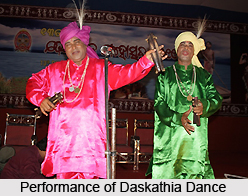 Daskathia dance is a popular folk dance performed in the Odisha state of India. This folk form is mainly associated with the worship of Lord Shiva and thus, during the performances, dedications to Lord Shiva, mentioning its various forms like Rudra, Hara, Mahadeva, Shankar, and Bholanath etc., is prescribed. Along with them, the greatness of other Gods and Goddesses such as Vishnu, Krishna, Ganesh, Durga and Kali etc., are also praised. The performance of Daskathia is considered as ritualistic and secular in nature.
Daskathia dance is a popular folk dance performed in the Odisha state of India. This folk form is mainly associated with the worship of Lord Shiva and thus, during the performances, dedications to Lord Shiva, mentioning its various forms like Rudra, Hara, Mahadeva, Shankar, and Bholanath etc., is prescribed. Along with them, the greatness of other Gods and Goddesses such as Vishnu, Krishna, Ganesh, Durga and Kali etc., are also praised. The performance of Daskathia is considered as ritualistic and secular in nature.
Etymology of Daskathia Dance
The name of the dance is derived from the words `Das` and `Kathi` meaning worshippers and sticks respectively.
Performers of Daskathia Dance
Originally, the performers for Daskathia dance were the low-caste Hindu community people however; people belonging to all other higher castes such as Kshyatriyas and Brahmins also started participating in it.
Performance of Daskathia Dance
The performance group consists of two people, a chief singer (Gayaka) and the other known as the `Palia`. The Palia plays a second fiddle to the singer, in acting and singing. Therefore, with the contribution of these two performers, the entire performance is staged. They act all the parts of the drama; change their tone and the pitch of their voice to hold the audience for a long time. They also introduce humorous stories to break the monotonous speech. Each performer has a pair of sticks used for playing. The actual performance begin with invocation verses that are normally composed by the local talented poets followed by the performance in chorus with each one striking his own stick in perfect tune with the other. The theme of performance is announced soon after that. The announcer, very loudly, usually does the recitation of themes. The theme is mythological for all the performances.
The performance of Daskathia is less musical comparing its dramatic effects. The dramatic part of it consist of verbose stanzas taken from various Puranic references and are presented with blending in vigour to appeal audience. Though, it is termed that the musical appeal is not widely used for such performances, the kind of music used is traditional in nature. This style of vocal recital is based on some patterns of tunes that are inherent from southern rural areas. A kind of inimitable type of music, used in the Daskathia is a distinctive contribution of Ganjam district of South Odisha. Accent used in the language, breaking of syllables with notes, typical pronunciations, pauses in sentences all these factors indicate a fusion of southern patterns in Oriya literature.
Costume of Daskathia Dance
The costumes of performers are rich and luxurious. They tie a turban on head and wear a long luish or silken coat. With such outlook, the Dasas create a visual attraction of the listeners by their gestures and postures.



















